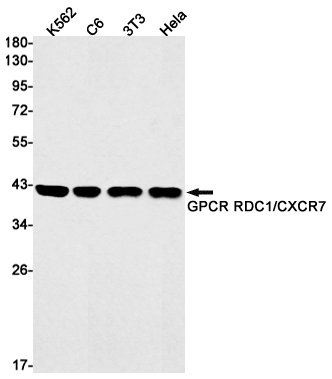-
Product Name
Anti-GPCR RDC1/CXCR7 Rabbit antibody
- Documents
-
Description
GPCR RDC1/CXCR7 Rabbit monoclonal antibody
-
Tested applications
WB, FC
-
Species reactivity
Human, Mouse, Rat
-
Alternative names
RDC1; CXCR7; RDC-1; CMKOR1; CXC-R7; CXCR-7; GPR159 antibody
-
Isotype
Rabbit IgG
-
Preparation
Antigen: A synthetic peptide of human GPCR RDC1
-
Clonality
Monoclonal
-
Formulation
Supplied in 50nM Tris-Glycine(pH 7.4), 0.15M Nacl, 40%Glycerol, 0.01% sodium azide and 0.05% BSA.
-
Storage instructions
Store at 4°C short term. Aliquot and store at -20°C long term. Avoid freeze / thaw cycle.
-
Applications
1:1000-1:5000
1:20
-
Validations

Western blot detection of GPCR RDC1/CXCR7 in K562,C6,3T3,Hela cell lysates using GPCR RDC1/CXCR7 Rabbit mAb(1:1000 diluted).Predicted band size:42kDa.Observed band size:42kDa.
-
Background
Swiss-Prot Acc.P25106.Atypical chemokine receptor that controls chemokine levels and localization via high-affinity chemokine binding that is uncoupled from classic ligand-driven signal transduction cascades, resulting instead in chemokine sequestration, degradation, or transcytosis. Also known as interceptor (internalizing receptor) or chemokine-scavenging receptor or chemokine decoy receptor. Acts as a receptor for chemokines CXCL11 and CXCL12/SDF1. Chemokine binding does not activate G-protein-mediated signal transduction but instead induces beta-arrestin recruitment, leading to ligand internalization and activation of MAPK signaling pathway. Required for regulation of CXCR4 protein levels in migrating interneurons, thereby adapting their chemokine responsiveness. In glioma cells, transduces signals via MEK/ERK pathway, mediating resistance to apoptosis. Promotes cell growth and survival. Not involved in cell migration, adhesion or proliferation of normal hematopoietic progenitors but activated by CXCL11 in malignant hemapoietic cells, leading to phosphorylation of ERK1/2 (MAPK3/MAPK1) and enhanced cell adhesion and migration. Plays a regulatory role in CXCR4-mediated activation of cell surface integrins by CXCL12. Required for heart valve development. Acts as coreceptor with CXCR4 for a restricted number of HIV isolates.
Related Products / Services
Please note: All products are "FOR RESEARCH USE ONLY AND ARE NOT INTENDED FOR DIAGNOSTIC OR THERAPEUTIC USE"
